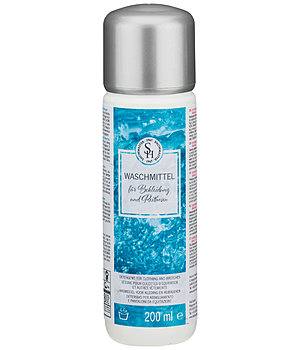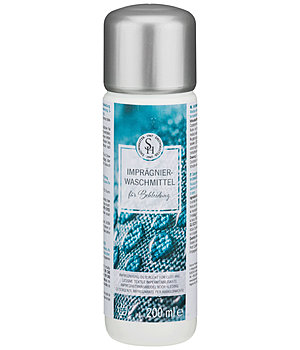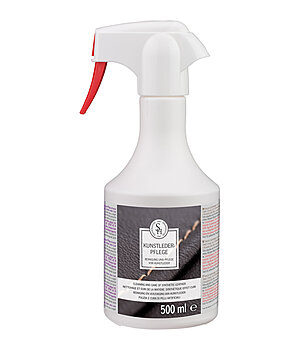Step-by-step care instructions for functional textiles in equestrian sports
There are various ways to remove dirt, dust and sweat from functional riding clothes. It is important to note that not all textiles may be washed, otherwise the protective outer material will be damaged and the functionality limited.

1. Which cleaning options are there?
Although washing and cleaning are often used to refer to the cleaning of clothes, there are differences in content. Washing is done with water, while some textiles may only be cleaned. During cleaning, water is replaced by a solvent that dissolves the dirt from the fibres. Water would swell certain functional fibres, causing the garment to lose its shape. Clothes that are to be dry cleaned only should be left in professional hands. Therefore, before cleaning, pay attention to the care symbols on the label.
Some functional materials have the property of protecting themselves from contamination by making water and dirt bead up on the surface. This fibre protection, also called DWR (Durable Water Repellent), is achieved by impregnation. This involves spraying an impregnation spray onto the surface. To maintain the effect for a long time, impregnated clothing should not be washed too often. Before you spray on a new impregnation, you can reactivate it. You can find out how to do this under point 7 „How do I impregnate my riding clothes correctly?“
The following applies to all functional textiles:
Wash as seldom as possible, as often as necessary to maintain the functionalities.
IMPORTANT!
Do not use fabric softener! This will cause the fibres to stick together and severely restrict the functionality of the materials.
2. Care instructions for breeches
Elastic materials with artificial leather trim are used for the most part in riding breeches. Real leather is only used in riding clothes for riding boots. To maintain the elasticity and the stable, velvety surface of imitation leather, follow these steps when washing:
- Before washing: Coarse dirt and animal hair can be removed with a soft brush. To prevent unnecessary friction in the washing machine, buttons and zips should be closed. Then turn the trousers inside out.
- Washing cycle: Follow the care symbols on the label. The riding breeches with synthetic trim can be washed at 30°C using a standard mild detergent, ideally a mild detergent for sports textiles. Never use fabric softener, as this can cause the functional fibres to stick together!
- After washing: Hang or lay the breeches on the line to dry. Do not put them in the dryer as the heat will damage the synthetic leather. The trousers should also be turned inside out for ironing. To ensure that you continue to enjoy your riding breeches with imitation leather trim for a long time, they should be treated with an imitation leather care product after washing and drying to maintain their suppleness. The artificial leather care by SHOWMASTER is ideal for this purpose.
3. Care instructions for soft shell jackets
Soft shell has a water-repellent surface whose impregnation is destroyed by too frequent washing. Therefore, the following applies to soft shells (as to functional textiles in general): wash as seldom as possible, as often as necessary. The more often the soft shell jacket is washed, the sooner it must be impregnated. You can read about how to reactivate or renew the impregnation of your soft shell jacket in section 7. If it does need to be washed at some point, pay attention to the following care steps:
- Before washing: Light soiling can be removed with a soft brush without washing. This will prevent too frequent washing. Before putting the jacket in the washing machine, close all buttons and zips and turn the jacket inside out.
- Washing cycle: If you follow the care instructions on the label, you can’t go far wrong when caring for your soft shell jacket. Use a mild detergent (no fabric softener) and put your machine on the gentle cycle at a low temperature of 30 or 40°C. Also set an extra rinse cycle. Also set an extra rinse cycle.
- After washing: The best way to dry soft shells is to air dry them on the line.
4. Care instructions for oilskin jackets
Oilskins are particularly easy to care for because they are largely self-cleaning. They must not be washed with soap or put in the washing machine. To avoid damaging the PU coating of your mackintosh, you should only remove dirt from it with a sponge and cold water.
Creases and folds occur very easily in Oilskin, which are characteristic of this fabric. They can be removed by careful ironing or blow-drying, as the heat liquefies the wax. However, this process should be avoided.
If the wax layer wears off, it can be re-waxed with an Oilskin wax impregnation for waxed and oiled textiles.
TO THE SELECTED TEXTILE CARE PRODUCTS
5. Care instructions for competition jackets
Competition jackets can now also be washed in the washing machine. Nevertheless, care should be taken, as there are always jackets with high-quality, velvety suede on the collar, which can come off if care is not taken.
- Washing: Again, follow the care label. Wash the competition jacket only on the delicate cycle at a maximum of 30°C. Avoid harsh detergents, cleaning agents or detergents with a strong detergent. Do not use harsh detergents, stain removers or the spin cycle.
If gentle care is too risky, the competition jacket should be taken to a professional cleaner.
- After washing: Hang the competition jacket on a hanger and let it air dry.
6. Care instructions for down jackets (and imitation down)
Down loses more of its natural fat content and thus its bulkiness with every wash. For this reason, down products should be washed as little as possible. However, if washing is unavoidable, the following points should be observed:
- Washing: Turn the jacket right side out and close all zips. To prevent over-stressing the jacket, the wash cycle is only set to 30°C with a maximum of 800 revolutions. Ideally, use a down detergent.
Caution: Do not use fabric softener!
- After washing: A tumble dryer is recommended for drying. It is best to place three tennis balls next to the down jacket to prevent the feathers from clumping together. Then hang the jacket out in the fresh air for days, loosening up any down clumps with your hands several times.
If the winter jacket with down lining is not worn during the summer season, it is hung loosely to prevent clumping.
Jackets with imitation down are much easier to care for, as the synthetic fibres have a better recovery and therefore do not clump together as quickly. Stick to the care instructions on the label and you cannot go wrong.

7. How do I impregnate my riding clothes properly?
If the impregnation of your clothing wears off, for example your soft shell jacket, you can reactivate the impregnation with heat. To do this, put the soft shell jacket in the tumble dryer at 60°C for 30 minutes. If there is no dryer, you can also treat the outer material with an iron or a hairdryer. Please be careful when ironing: avoid direct contact of the fabric with the hot iron by placing a cloth between them!
If the impregnation cannot be reactivated, you can spray on a commercial impregnation spray.





